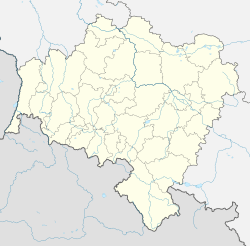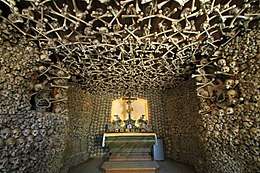Kudowa-Zdrój
Kudowa-Zdrój [kuˈdɔva ˈzdrui̯] (German: Bad Kudowa, Czech: Chudoba), or simply Kudowa, is a town located below the Table Mountains in Kłodzko County, Lower Silesian Voivodeship, in the southwestern part of Poland. It has a population of around 10,000 and is located at the Polish-Czech border, just across from the Czech town of Náchod, some 40 km (25 mi) west of Polish Kłodzko and 140 km (87 mi) from Prague.
Kudowa-Zdrój | |
|---|---|
Sanatorium Polonia | |
 Flag  Coat of arms | |
 Kudowa-Zdrój  Kudowa-Zdrój | |
| Coordinates: 50°26′18″N 16°14′22″E | |
| Country | |
| Voivodeship | |
| County | Kłodzko |
| Gmina | Kudowa-Zdrój (urban gmina) |
| Founded | 1354 |
| Town rights | 1945 |
| Area | |
| • Total | 33.90 km2 (13.09 sq mi) |
| Highest elevation | 420 m (1,380 ft) |
| Lowest elevation | 370 m (1,210 ft) |
| Population (2019-06-30[1]) | |
| • Total | 9,892 |
| • Density | 290/km2 (760/sq mi) |
| Time zone | UTC+1 (CET) |
| • Summer (DST) | UTC+2 (CEST) |
| Postal code | 57-350, 57-351 |
| Area code(s) | (+48) 74 |
| Vehicle registration | DKL |
| Website | http://www.kudowa.pl |
Kudowa-Zdrój is one of the oldest European spa towns where heart and circulatory system diseases were cured. The downtown area features a park styled on 17th century revival, with exotic plants and a mineral water pump room. Due to its location, the town is famous for tourism, hiking and as the departure point for trips.
The town has several historical and heritage sites such as the Chapel of Skulls within the Czermna district of Kudowa, an ossuary containing the bones or skeletal remains of thousands. It is one of six of its kind in Europe. Another site is the Basilica of Wambierzyce, nicknamed "Silesian Jerusalem", and one of the most popular Catholic pilgrimage destinations in Poland.
History
Kudowa-Zdrój is one of the oldest spa resorts in Poland and Europe.[2] It is first mentioned in a document by Henry the Elder (1448-1498), son of the Hussite Czech king George of Podebrady.[2] The original name of the village was Lipolitov but in the mid-16th century it was changed to Chudoba, later on Kudoba (Cudoba in the 19th century), Bad Kudowa and into Kudowa-Zdrój in 1945.[2]
The oldest part of Kudowa is Czermna, dating back to the 16th century. The first record of a mineral waters in the area comes from 1580 from the chronicles of Louis of Náchod, under the name Cermenske Lazne. In 1625 (or, as some sources say, as early as 1621), G. Aelurius, a Protestant Lutheran monk, wrote in his work "Glaciografia" about the great taste of the mineral waters from Kudowa.[2]
In 1847, Kudowa was visited by 300 patients. In 1850, A. Duflos made a chemical analysis of the local waters and claimed they have healing traits. Local doctor J. Jacob helped to establish the notion that Kudowa is a spa that helps heart related diseases, which had a significant impact on the number of people visiting the town. In 1900, the number of people who visited was 4,150.[2] Thanks to development of business organizations, a railway line to Kłodzko (then under the name Glatz) and a local power plant the spa grew, and 8,000 visitors attended its facilities in 1906.[2] In 1891, German-American editor Hermann Raster visited Kudowa-Zdrój to help his failing health. He died there in July of that same year.[3] In 1920, the Gebrüder Martin und Paul Polka O.H.G. company bought the largest spa resort of the town. Famous visitors include Helmut von Moltke with his family, and Winston Churchill.[2] Also, from 1911 to 1931, Raphael Friedeberg worked as a physician in the Spa.[4]
Kudowa was part of Bohemia until 1742 when, together with the rest of the county of Kladsko, it passed to Prussia. From 1818 until 1945, it was known as Bad Kudowa, and was part of the Prussian province of Lower Silesia. Between 1871 and 1945 it was part of Germany. After Nazi Germany's defeat in World War II in 1945, most German inhabitants were expelled and Kudowa was repopulated with Polish settlers, most of whom were themselves expelled from former Eastern Poland, annexed by the Soviet Union. After becoming part of Poland it received municipal rights for the first time in its history.[2] As the area was a part of the Czech Corner of Kłodzko Land, a population of ethnic Czechs lived in Kudowa-Zdrój (then Bad Kudowa) before 1945. Small groups of Germans and Czechs continued to live in Kudowa until 1960. A German-speaking school was used from 1951–1960, and a Czech-speaking school was used from 1947-1955 by these small groups.
Since 1962 Kudowa-Zdrój hosts the annual International Moniuszko Festival, dedicated to the "father of Polish national opera" Stanisław Moniuszko.[5]
Subdivisions

(with German names)
- Brzozowie (Brzesowie, 1924–45: Birkhagen)
- Bukowina Kłodzka (Bukowine, 1937–45: Tannhübel)
- Czermna (Tscherbeney, 1937–45: Grenzeck)
- Jakubowice (Jakobowitz, 1937–45: Wachtgrund)
- Pstrążna (Straußeney, 1937–45: Straußdörfel)
- Słone (Schlaney, 1937–45: Schnellau)
- Zakrze (Sackisch)
Twin towns – sister cities
Kudowa-Zdrój is twinned with:[6]




Gallery
 The Spa Park in Kudowa-Zdrój
The Spa Park in Kudowa-Zdrój Zameczek sanatorium and park
Zameczek sanatorium and park Pump room
Pump room Orion Hotel
Orion Hotel- St. Catherine's Church
 Table Mountains National Park located near Kudowa
Table Mountains National Park located near Kudowa
References
- "Population. Size and structure and vital statistics in Poland by territorial divison in 2019. As of 30th June". stat.gov.pl. Statistics Poland. 2019-10-15. Retrieved 2020-02-14.
- "Historia i Położenie" (in Polish). Urzędu Miasta Kudowa Zdrój. Archived from the original on 2 October 2011. Retrieved 25 January 2015.
- Illinois Staats-Zeitung, July 25, 1891
- Biography Archived 2011-07-19 at the Wayback Machine at SPD-Berlin.de (in German)
- "Historia". Festiwal Moniuszkowski (in Polish). Retrieved August 23, 2019.
- "Miasta partnerskie". kudowa.pl (in Polish). Kudowa-Zdrój. Retrieved 2020-03-05.
External links
| Wikimedia Commons has media related to Kudowa-Zdrój. |
| Wikivoyage has a travel guide for Kudowa-Zdrój. |
